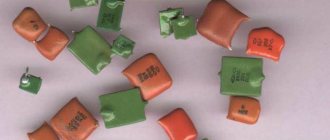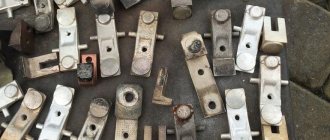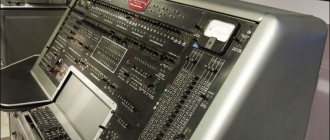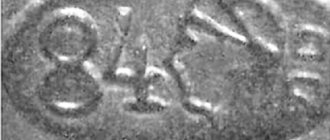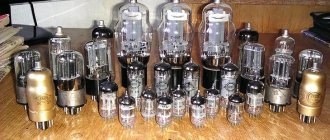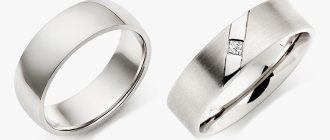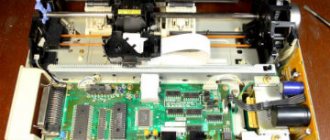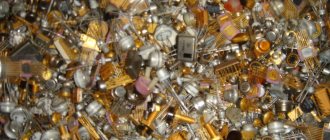The “gold rush” in a modern way is not a search for a promising vein in the vastness of Siberia, followed by exhausting digging, washing out grains of the coveted metal.
To become the owner of precious metals today, you need to buy household radio and electrical appliances from the population that have lost practical interest, and, armed with a “young chemist’s” kit, engage in refining - the purification of secondary precious metals (SPM).
If you have information about which household devices and office equipment contain the largest amount of gold, silver, platinum, platinum group metals (palladium, iridium, etc.), refining becomes not just an entertaining chemical experience , but a cost-effective production.
The realities of the modern economy dictate that manufacturers use minimal precious metals in the manufacture of various gadgets, which cannot be said about the era of active construction of communism.
Therefore, household appliances produced in the Union, or more precisely, elements of devices, contained a large amount of precious metals. It is this equipment that is the target of buyers.
Why are gold and other precious metals used in equipment?
Gold, platinum, silver, as well as other valuable metals (copper, brass, etc.) are unsurpassed conductors, which ensures the uninterrupted functioning of high-tech computer and other devices.
In addition to this technical parameter, precious metals do not oxidize .
This characteristic, in turn, directly affects a significant increase in the service life of the same high-tech devices, which include various equipment:
- TVs;
- refrigerators;
- washing machines, etc.;
- office equipment (printers, faxes, etc.).
USSR TVs
This gadget was previously released in two versions : a tube device and a transistor device.
It makes no sense to buy tube TVs, since precious metals are contained in these devices only in the beam tetrode - the largest lamp marked 6P36S, 6P44S, 6P45S, GU50.
Another thing is transistor TVs. There is an abundance of precious metals here.
Buyers are interested in the following elements :
- microcircuits encased in plastic housings;
- transistors marked KT814, KT940, KT310, KT502, KT503;
- AL307 LEDs in the channel switching unit;
- “yellow” (according to the color of the case) transistors KT203, located in the SMRK unit and in some variants (models) on other boards;
- capacitors KM-1;
- “yellow”, sometimes “red” capacitors K10-17, etc.
Any product is subject to careful inspection, since products of this type, produced in the Union, were distinguished by a variety of models .
In addition, one device could have different configurations, both containing precious metals and not using them.
We bring to your attention a table that shows which USSR TVs contain valuable elements and how many there are. The mass of precious metals in one product is given in grams.
| Model | Au (gold) | Ag (silver) | Pt (platinum) | Pd (palladium) |
| Knight | 0,3412 | 7,4606 | 0,622 | 0,3199 |
| Horizon-Ts355 (Ts355D) | 0,6785 | 3,7443 | 0,43 | 0,318 |
| Rainbow-719-1 | 0,3135 | 7,1795 | 0,6294 | 0,0339 |
| Rubin Ts202 (Ts208) | 0,4443 | 3,6787 | 0 | 0 |
| Electron-736 | 0,24 | 6,33 | 0,225 | 0,0338 |
If we compare the content of precious metals in Soviet TVs “Horizon”, “Vityaz”, etc. with imported ones, it is worth noting that a device manufactured in Japanese and Chinese, Taiwanese or Korean assembly contains only 0.1474 g of gold and 2.4859 g of silver.
Where can I find the product?
You can (and even need to) start collecting a “starting batch” for your first sale from your own home. Disassemble your closet (or balcony - many of our compatriots have the habit of storing outdated belongings there) and conduct an audit for the presence of unused Soviet-style equipment. A TV, radio, transistor - anything will do. The main thing is that this technique contains parts containing metals. Disassemble the found rarities for spare parts and put aside all the parts that can be useful in this business - you will later take them to the reseller (or, if you have already found a direct buyer, then directly to him) to receive the first fee for your efforts. And solemnly take all unnecessary elements to the nearest trash heap. Now we can say that the disassembled things have really lived out their life, having finally managed to serve the owner well. And a pleasant bonus for the work done will be the realization that you have cleaned up the house, made room for the necessary things and got rid of excess junk.
Having sorted out your home, ask your relatives and friends - maybe they also have old equipment from the category of “wasting space, but it’s a pity to throw it out” in their home? If the answer is positive, offer your help in getting rid of the trash - for pickup or a nominal fee of 100-200 rubles. Many people themselves happily give away unnecessary equipment, because they do not see its value and keep it simply out of nostalgic habit.
Expand your supplier base using online message boards. Place an ad, declaring yourself as a person willing to buy and remove bulky old equipment, and wait for calls with offers. Or look for offers yourself - many people are ready to sell old TVs, receivers and other similar things for a nominal fee. Your job is to contact these people, come to them and buy back what they give.
Villages and hamlets are a real treasure trove of Soviet technology. Rural residents are much more thrifty and thrifty than urban residents, and their morality does not allow them to throw away even spoiled and obsolete things, since any item can be used in the household. Sometimes broken equipment actually finds a second life, but most often it is destined to gather dust somewhere in the farthest corner of the barn so that it does not become an eyesore with its uselessness. If you have a personal car or the opportunity to rent a car for temporary use, be sure to use this advice and take the time to travel to the small village closest to your city. Go door to door and talk politely with the villagers (mostly older people). You will be surprised how much equipment you can find for your business, and how willingly the villagers will give you unnecessary rubbish - for them the nominal payment you offer will be much more significant than for your city relatives and friends.
Computers
Soviet-style electronic computers contain in their design many capacitors marked KM, K10-17, as well as “yellow” microcircuits in plastic or ceramic shells . These are elements containing precious metals.
There are also gold-plated connectors, contact pads and other elements suitable for refining.
In computers from abroad, the processor is valued. There is a particularly high gold content in processors housed in a lilac ceramic case .
We suggest that you familiarize yourself with the table with the content of precious metals in some computers and their processors. The mass is also given in grams per device.
| Model name | Au | Ag | Pt | Pd |
| Elbrus-1-KB | 2668 | 7737,4 | 259 | 639 |
| Electronics-60 | 17,93353 | 29,85809 | 6,46067 | 5,86536 |
| ШК-1700.02601 | 1384,33 | 1679,95 | 83,01 | 15,88 |
| SM1307.604 | 113,9996 | 96,5643 | 0,0974 | 2,0039 |
| Personal computer | 10,972 | 5,84 | 0,082 | 0,267 |
| EC-1842.03 | 12,886 | 13,839 | 0,481 | 1,387 |
| DVK-2M | 13,185 | 26,0418 | 5,0743 | 2,8305 |
Foreign-made computers manufactured before 1990 contain elements similar to domestic parts marked K10-17. These capacitors are accepted at the same price at which domestic parts are purchased.
What will we sell?
So, what parts will be in greatest demand among resellers and direct buyers? What will you get paid more for?
The most valued are transistors, resistors, various connectors, capacitors and, of course, microcircuits - they contain the most precious metals, and therefore they cost more. For various types of switches, relays and thermocouples, you will be paid an order of magnitude less - however, these parts can also be turned into incidental income, because this is much better than simply throwing the thing in the trash and the money down the drain.
Now let's talk about specific models and their prices. Perhaps the most expensive lot among Soviet spare parts are capacitors belonging to the KM5 N30 series (green parts). If you collect a kilogram of such capacitors, resellers will be willing to pay about 80 thousand rubles for such a quantity of goods - you must agree, this is a substantial amount and is worth the effort you will spend on finding the equipment. Another series of capacitors that can fetch good money for selling is KM 5D (they are also characterized by a green color). A kilogram of these spare parts will cost about 50 thousand rubles.
Microchips can also be sold quite expensively. Their total price varies from 100 rubles to 1000 rubles and depends on the specific model. The highest price - about 1000 rubles (and sometimes more) - can be obtained for microcircuits marked “140”, “155”, “170”, “172”, “544” and “574”.
Connectors can also be sold quite expensively - the most popular models will bring a profit of more than 1,500 rubles per piece. But resellers do not value resistors so highly - their price is about 15 rubles per part.
It is worth noting that the indicated prices are relevant for cooperation with resellers of non-ferrous metals. If you yourself are concerned about finding direct buyers, then the price for the product you offer can increase several times, since resellers mark up 2005-300% of the original cost of spare parts.
Cell Phones
The old cell phone that many of us have lying around unused at home contains:
- Au – 0.024 g;
- Ag – 0.25 g;
- Pd – 0.009 g;
- Ta (tantalum) – 0.4 g.
And this is not counting non-ferrous metals (copper, tin, etc.). Precious metals are found in circuit boards and in all live contacts of cell phones.
From 40 cell phones that have lost practical interest, the same amount of gold is mined as is mined from 1 ton of gold ore.
Where to look for it?
So, we figured it out - cell phones contain precious metals. But in order to find them, you need to know where to look. Gold in the phone can be:
- on old mobile phones you can try on the button contacts;
- very often there is a lot of gold on the contact pads of microcircuits;
- somewhat less of this precious metal can be found inside the microcircuits themselves;
- a lot of it is found on the coatings of the contacts of cables and coaxial antennas;
- According to some reports, gold can also be extracted from speakers and microphones.
Printers
This type of office equipment, from a profitability point of view, is the most unprofitable investment .
Of course, this equipment also contains precious metals.
In particular, gold-plated contacts of the print head and cartridges.
Copiers - photosensitive elements - are coated with noble metal.
However, the amount of precious metals in printers is so negligible that “the game is not worth the candle.” For example, foreign equipment in this category contains 0.01 g of gold and 0.8 g of silver. A domestically produced product, model CM6329 02M, boasts only 0.01 g of “yellow” metal.
Refrigerators
It doesn’t matter whether the household unit was manufactured in the Union or has been released from the assembly line at the present time, all refrigerators, or rather thermostats, have silver contacts, as well as soldering with PSR solder.
Consider the most popular brands :
- Nord-155 contains 0.0012 g Au and 6.21 g Ag;
- The Smolensk brand refrigerator can boast the same amount of precious metals;
- Mir-101-1 – 3.177 g Ag;
- Minsk-126 – 2.38 g Ag;
- Zyl - 1.326 g of the same metal;
- Don – 1.8 g Ag.
In general, it is also quite meager . Whether it’s televisions or high-precision equipment, not to mention equipment intended for the military-industrial complex of the USSR.
Tape recorders and radios
These units, produced in the Union, also had elements containing precious metals in their designs.
The most valuable items
in tape recorders :
- “black” microcircuits in a plastic shell (174un7 and other parts);
- powerful transistors marked KT802 and similar elements - KT814, KT503, KT203, KT3102;
- “yellow” chips located in the indicator controller.
Such elements are found in the legendary Mayak tape recorder of the 80s, as well as in devices similar to it .
In tape recorders, precious metals can also be contained in capacitors, relays, switches, and other elements; noble metals in radiols are contained in capacitors.
In addition, silver contacts of range switches are often found. Let us consider in the table the content of valuable elements in some tape recorders.
| Model | Au | Ag | Pt | Pd |
| Electronics-004K | 1,04 | 6,319 | 0,0705 | 0,1067 |
| Sonata | 0,3129 | 0,6072 | 0,001 | 0,0035 |
| Mayak-233 stereo | 0,1853 | 0,96935 | 0 | 0 |
| Legend-404 | 0,688 | 0,0632 | 0,001 | 0,0042 |
| Belarus-302 | 0,0308 | 0,2174 | 0,001 | 0,1493 |
Refining of precious metals
There are several ways to remove VDM from recycled equipment .
For home use, the electrolysis method is primarily suitable.
To do this you will need:
- capacity;
- hydrochloric or sulfuric acid as an electrolyte;
- a cathode made of lead or steel;
- an anode made of gold, in the case of refining of this particular precious metal;
- power supply providing alternating current.
In addition to electrolysis, precious metals can be “etched” chemically - using a mixture called “aqua regia”. This composition is a mixture of hydrochloric and nitric acids in a ratio of 3:1.
Refining of various items and parts is carried out in a way that will allow you to obtain the necessary elements with minimal losses.
How to get gold from a mobile phone?
The technology is quite simple, but it is worth observing safety requirements. When working with concentrated hydrochloric acid, you only need to wear a mask and goggles, and you must wear special gloves on your hands.
You will need to pour hydrochloric acid into a glass container and fill it with broken microcircuits from mobile phones. The cases do not need to be thrown into hydrochloric acid, since there is nothing valuable in them!
Sell gold
After a week of chemical fermentation, there will be nothing left of the microcircuits, and grains of gold will remain at the bottom.
Do not forget that all components of a mobile phone - iron, copper, tin, even silver - react with strong hydrochloric acid. Only gold and palladium do not participate in the reaction and precipitate. ◄ Back to news


